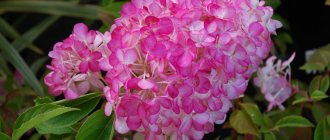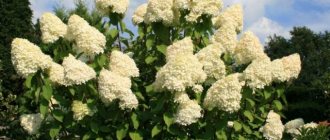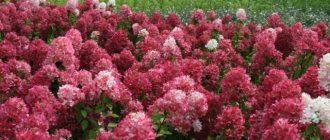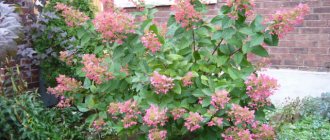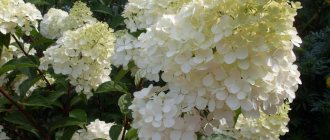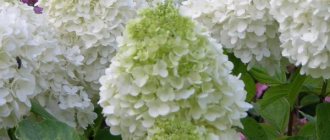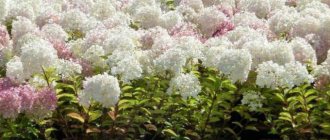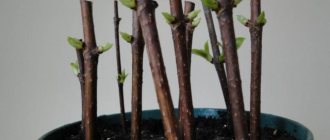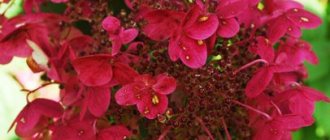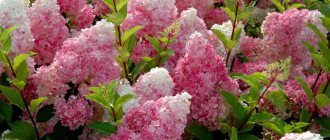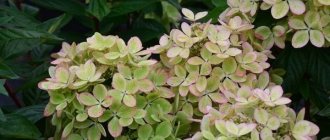Plants » Flowers
0
228
Article rating
Kira Stoletova
In 1789, the English scientist Joseph Banks brought hydrangea to Europe from China. The plant immediately won the love of gardeners, and the best breeders in France began to breed new species. This is how the Phantom hydrangea appeared, which became popular in Russia. Due to its frost resistance, the variety is grown even in the Far East.
Phantom hydrangea
Description of paniculata hydrangea Phantom
According to the description of the variety, Phantom hydrangea is characterized by its large size. It is quite spreading, its diameter is usually approximately 2 m. The Phantom variety of hydrangea shrub can reach 2.5 m in height. Sometimes you can find even larger plants.
The young shoot of this variety has a bright green color, while the mature shoot is red-brown. Strong branches can easily withstand large blooms. The foliage on the bush is quite large and whole. It is painted dark green. The leaves of this variety do not differ much from other types of paniculate hydrangeas.
A few photos of Phantom hydrangea:
Many gardeners admire in their reviews the flowering of Hydrangea paniculata variety Phantom. The flowers are quite large and have a wide pyramidal shape. The length of the inflorescences can reach 30 cm. The flowers are painted in a delicate light green color. Later the color gradually turns into light pink.
A plant of this variety can be planted in regions with both warm and cold climates. The most important thing is to provide the culture with the care it needs.
Features of flowering hydrangea Phantom
The flowers of paniculate hydrangea Phantom have the following characteristics:
- the shade of the petals is light green or light pink;
- width of flowers - 1 cm;
- diameter of inflorescences - up to 30 cm;
- shape - wide pyramidal.
The crop begins to bloom 4 years after planting. The period when the first flowers appear is late June or early July. Flowering continues until the first frost. Paniculate hydrangea variety Phantom has high winter hardiness characteristics. The culture is able to withstand temperature drops, without additional shelter, down to -23°C.
Important! The cultivation period, subject to quality care, does not exceed 40 years.
Source
Drought resistance and winter hardiness of hydrangea Phantom
Hydrangea paniculata variety Phantom has a fairly high resistance to frost. It is able to survive without shelter even in regions where winter temperatures are below -20°C. However, experienced gardeners still strongly recommend covering shrubs for the winter, since there is a small chance that the branches will freeze.
This plant is very moisture-loving and does not like drought. That is why during hot periods it needs additional watering.
Resistance to diseases and pests
Hydrangea paniculata Phantom (also known as Hydrangea Paniculata Phantom) is immune to many diseases. It is especially resistant to diseases that often occur in wetlands.
However, this variety can still encounter diseases and pests such as:
- chlorosis;
- gray rot;
- septoria;
- rust;
- leaf aphids;
- spider mite;
- slugs
Also, the Phantom variety may encounter the following problems:
- yellowing of foliage;
- drying out and falling of leaves;
- dry blackening of foliage;
- wet darkening.
What types of hydrangea Phantom are there?
The parent of the Phantom hydrangea was a variety of hydrangea called Paniculata. All the best characteristics taken from this variety have been preserved. At the same time, some advantages have significantly increased. For example, Phantom is a more resilient variety in terms of diseases and low temperatures. For these reasons, this variety of hydrangea is quite popular among gardeners living in rather harsh regions.
Most often in such areas you can find tree-like, large-leaved and paniculate hydrangea. In addition to the above varieties, you can also distinguish deciduous and evergreen hydrangea. There are a great variety of them. In its height, the plant can reach either one meter or three meters. Under natural conditions, Paniculata can grow seven to eight meters in height.
The tree-like variety of Phantom, as a rule, reaches no more than three meters in height. The leaf blade has an oval shape, slightly elongated. The leaves reach about twenty centimeters in length. Small flowers are grouped in large lush inflorescences, which are no more than twenty-five centimeters long. As for possible colors, even one variety can have several of them. This hydrangea blooms from June until the end of warm weather.
Some gardeners note that this crop is able to go into winter while in bloom. Phantom, which blooms with white flowers, at the end of the season changes the color of its petals to a pleasant slightly green tone.
Flowers, when cut, are able to maintain their beautiful appearance for a long time. At the same time, the shape of the inflorescences and the color of the flowers are preserved. For these reasons, the tree form of hydrangea, in particular Phantom, is very popular in the floristic and design environment.
It must be admitted that growing tree hydrangea is somewhat difficult in regions with cold climates. This is due to the fact that such hydrangea has average resistance to low temperatures. If you want the plant to bloom well, then in the spring it must be pruned.
As a rule, plants are pruned in early April. Hydrangea feels best in well-moistened soils that have a sufficient amount of nutrients. The acidity level should not be high.
Description of the variety
Hydrangea Grandiflora paniculata - description, planting and care
Paniculate hydrangeas have been grown in eastern countries for a long time. In the 18th century, breeders took up them. As a result of their work, a bush with amazing frost resistance and beauty was obtained.
Hydrangea paniculata Phantom grows up to 2.5 meters in height. One bush covers an area of about two meters. The branches are strong, grow straight up, and are colored brown with a hint of red. The leaves are green, large, with a pointed apex and serrated edge.
The formation of buds begins at the end of June and continues until the end of October. The flowers are large, collected in a dense pyramid. Inflorescences grow up to 35 cm in length. At the beginning of flowering they are creamy and become pink over time. Buds are formed from July to September. The sterile flowers give off a subtle honey aroma that can be smelled far from the plant. Cut brushes stand in water for a long time.
Hydrangea Phantom prefers fertile soils with good moisture. Does not grow well in open areas in direct sunlight. Strong winds will also cause damage to the bush.
Hydrangeas in the garden
Breeders managed to preserve the natural frost resistance of the Phantom hydrangea. Although it can withstand frosts down to −25 degrees, in areas with harsh winters the plant should be covered. The plant, protected from the cold, will overwinter even in temperatures of −40 degrees.
Features of growing paniculate hydrangea Phantom
This specimen is a very moisture-loving plant. Of course, you don’t need to create swampy soil for it, but you also shouldn’t let it dry out. So to speak, the soil should be moderately moist. The composition of the soil itself does not need anything special. But, it will develop better in a neutral or acidic environment.
If Hydrangea paniculata Phantom is planted in full shade, it simply will not bloom as well as, for example, in partial shade and sun. If the soil is not acidic or neutral, then the flowers may not be so bright. It will grow well in clay soil, and will not grow at all in sandy soil.
Therefore, we draw the right conclusions! The more acidity in the soil, the better it will develop.
That is why lemon juice or acid is often added to the water when watering. Pine needles, sawdust, or even peat are added to the planting pit for acidification.
Source
Why choose hydrangea
Hydrangea paniculata phantom (hydrangea paniculata phantom) is a representative of the flora of the Far East.
Japan, China, Korea and even Sakhalin are places where hydrangea has been revered since ancient times. The flower became a cultivated plant only in the sixties of the 18th century. During this time, breeders managed to obtain various varieties, including the tree-like Phantom hydrangea.
Modern varieties have a number of advantages compared to the wild representative:
- Adaptation to harsh conditions is 100%, so the growing area increases from year to year. Calmly withstands frosts down to -25 degrees. After wintering it recovers quickly.
- Abundant and colorful flowering surprises even the most experienced gardeners.
- An unpretentious plant can be grown in one place for many years without compromising its attractiveness.
- Hydrangea Phantom takes root on any soil.
- The root system is practically not sick.
- Can be grown as a tree or in bush form.
- Easily propagated by dividing the bush, layering and cuttings.
Important! If you decide to grow the Phantom variety, choose a place where there is no sun and wind.
All of the above main advantages also apply to paniculate hydrangea Phantom; according to reviews from gardeners, they are quite true.
Reproduction methods
Hydrangea is easy to propagate in several ways. Some of them are simple, some are only available in certain conditions and require experience.
Cuttings
It is better to cut cuttings in the summer, choosing young, spring shoots. Several cuttings are obtained from one branch. Each of them should have 3-4 buds. Root the cuttings in a light substrate in a flowerpot or special greenhouse on the site.
Rooting in summer at an air temperature of +22-25 °C takes 2-3 weeks.
From the flowerpot, the cuttings are transplanted into the garden in the fall and left in the greenhouse until next year.
By layering
Adult plants over 5 years old are suitable for propagation by this method. In spring, the side branches are taken away, bent to the ground and dug into the ground. To prevent the branch from moving, it is pressed down with a stone. The place where it touches the ground is often watered. Within a month, rooting occurs.
It is allowed to separate the cuttings in the fall, but it is better to keep them “in a bunch” until next summer. Having overwintered next to the main bush, the shoot will have a better chance of strengthening and growing to adulthood. After a year, its root system is already strong enough to feed the new young plant on its own.
Dividing the bush
In early spring, a dense plant is subjected to a division procedure. The side part is cut off with a shovel and planted in a new place according to all the rules. If the bush is not yet too large, it is easier to dig it up entirely and divide it into parts, each of which will have a separate growth point. Thus, the plant will rejuvenate and will grow and bloom better.
Description and characteristics of flowering
As for the characteristics of flowering, paniculate hydrangea begins to bloom at about 3-4 years of age. This may upset some gardeners with such a long wait, but on the other hand, even a lush bush of this plant can already decorate your garden, especially if it is planted along the fence. The flowering itself begins smoothly, and the bush gradually acquires inflorescences from the first days of July to mid-October.
It is worth noting the fact that the newly blossomed petals have a light cream color, but later the petals acquire a white color, sometimes with shades of pink (rarely) or light green (more often) (see photo). Hydrangea “Phantom” blooms every year, right up to old age. If the bush is fertilized and fed, the number of inflorescences will not decrease with age, and sometimes it may increase even in adulthood.
Separately, it is worth mentioning the features of the paniculate hydrangea “Phantom”, thanks to which this plant is a welcome guest in any garden plot:
- The bush has high frost resistance and does not require special preparation for winter even in northern latitudes;
- Trimmed or damaged shoots regenerate very quickly and are unable to cause significant harm to the health of the bush itself;
- It is extremely unpretentious, can grow on poor soil, even without fertilizer (it is recommended to fertilize so that the flowering is more luxuriant);
- The root system is extremely resistant to various kinds of diseases of fungal, bacterial and parasitic nature, regardless of the soil in which the bush is located;
- It has an extremely unusual and beautiful appearance for our latitudes, which simply cannot go unnoticed.
The appearance of the plant and its physiological characteristics are described in detail in the following paragraphs:
- The inflorescences have a similar form factor to chestnut “candles”, and their average length varies from 30 to 50 cm;
- Color variations of inflorescences can be from light cream shades to pink-burgundy;
- The bush has a very powerful and developed root system, which is massive and reaches enormous sizes, exceeding the circumference of the crown;
- Paniculate hydrangea, like most other species of this plant, can be identified by its delicate, but at the same time relatively strong odor.
Planting and caring for paniculate hydrangea Phantom
In order for this variety of hydrangea to actively grow and develop, it is necessary to approach the choice of time and place of cultivation responsibly. Planting material and soil should also be prepared.
When to plant Phantom hydrangea
In the regions of central Russia, the Phantom variety of hydrangea is best planted in the spring. Then the young shrub will be able to get used to new conditions and form a full-fledged root system. But this can only be achieved if you follow the rules for planting and caring for the plant.
Selecting a location and preparing the soil for Phantom hydrangea
The Phantom variety is suitable for growing in open, light areas. The crown, like the root system, is very branched and wide, so it cannot be planted close to the wall of a house or other building. In addition, the shadow will interfere, flowering will be uneven, one-sided, and not so long-lasting.
The hole must be prepared in advance, in the fall, so that the seedling can be placed there immediately after the snow melts. The dimensions of the pit are 80 x 80 x 60, or even larger. Drainage is laid at the bottom - red brick, stones, crushed stone, large expanded clay. Then pour out nutritious soil mixed with leaf soil, humus, peat and coarse sand.
Hydrangea does not tolerate acidic soils. If the acidity of the soil is high, then before planting the soil must be mixed with dolomite flour or lime. The area should be flat or slightly elevated, not a lowland in which water will stagnate. The variety will not grow properly if the roots are constantly wet. And it is much more difficult to winter in waterlogged soil.
Preparation of planting material
Rooted cuttings or young seedlings should be carefully examined.
A healthy seedling is green, with smooth bark, without growths and bumps, cracks and chips. The buds are alive, swollen, the roots are dense, without plaque or putrefactive odor. If, when running your fingernail along the surface of the root, the white part is exposed, the roots are healthy.
If the seedling was sent by mail, then during the journey it managed to lose some of the moisture from the branches and roots. It must be placed in water or Ecosil solution for 6-10 hours.
Homemade cuttings bred independently do not need to be soaked before planting, but rather the roots can be sprayed with a solution of the fungicide Fitosporin or ordinary potassium permanganate.
Algorithm for planting paniculate hydrangea Phantom
The planting hole should be about 60 cm in diameter. Its depth should be approximately 50 cm. The pit must be filled with fertile soil mixed with peat.
The distance between planted seedlings should not be less than 1 m. Before planting the plant, its root system must be shortened. Also, the buds on the shoots should be cut off. You should leave about 3 buds on them. Thanks to this, the hydrangea will become lush.
The seedling must be placed in the prepared hole so that its roots are straightened and fit freely in the recess. Fill the soil on top. The root collar should be located on top.
After this, the soil must be watered and mulched. To do this, you should use peat, sawdust, pine needles, film or straw. This will promote ventilation.
Shelter for the winter
Paniculata hydrangea Phantom needs to be specially prepared for winter. Everything is done in stages:
- In September, reduce watering. If it rains, the bushes need to be covered so that water does not get on the roots.
- They are fed with phosphorus and potassium fertilizers so that the shoots have time to ripen. Nitrogen fertilizers are prohibited from being used in autumn!
- The tree trunk circle is covered with mulch and pruned. The remaining shoots are tied as shown in the photo.
- Although Phantom hydrangea is a frost-resistant plant, in regions with harsh winters it is better to play it safe and cover the plants. After all, buds will not bloom on frozen shoots.
The shelter is constructed from wooden boxes or frames are made. Spruce branches and non-woven materials can be used as covering materials. They must be fixed so as not to be blown away by the wind. This is the final stage of sheltering; it is carried out with the onset of stable frosts.
There are many shelter options, some of them are shown in the photo below.
Important! Well-sheltered bushes tolerate temperatures of -40 degrees.
Adult plants do not need to be covered, but only mulched over the roots. With the onset of spring days, the shelter is removed.
Caring for Hydrangea Phantom
A particularly important condition for obtaining beautiful Phantom hydrangea inflorescences on your site is care. The plant needs standard procedures such as watering, mulching, fertilizing and pruning.
Watering
The main mistake gardeners make when caring for young hydrangea seedlings is overwatering.
It is optimal to water once every 10-12 days. Even in summer, it easily tolerates dry periods without rain, but excess moisture can be destructive.
Young seedlings are watered with settled water in a bucket under the bush:
- In summer - once every 10-12 days;
- The rest of the time - once every two weeks.
An adult bush requires at least 20 liters of water at a time.
Top dressing
In early spring, hydrangea needs to be fed with nitrogen for a faster awakening from winter sleep and the beginning of active growth of green mass. It’s better to feed the bush at this time:
- Ammonium nitrate - 35% pure nitrogen
- Ammonium sulfate - 21% nitrogen, 24% sulfur
- Urea - 46% nitrogen
- Calcium nitrate - 12% nitrogen, 19% calcium. Calcium improves nitrogen absorption.
In summer, phosphorus and potassium are required for the formation of buds. During this period, the bush can be fed with such preparations as:
- Nitrophoska - you can dig granules around the bush or dissolve them in water and water the plant;
- Nitroammofoska is a complex phosphorus-potassium fertilizer, applied before flowering;
- Diammofoska - 26% phosphorus and potassium, 6% nitrogen. Also contains zinc, sulfur, iron, magnesium.
- AVA - does not contain nitrogen, is easily absorbed by plant roots. Widely used in the West in the care of flowering garden crops.
Rules for caring for and growing in the garden
If the bush is well cared for, it can grow and bloom for up to 40 years. Let's look at what plant care includes.
Watering and fertilizing
Shrubs are quite moisture-loving, so you need to ensure that the soil under the bushes does not dry out. During the growing season, if there is no precipitation, watering is done once a week at the rate of 1.5–2 buckets per bush. Experienced gardeners advise sometimes using a weak solution of potassium permanganate for watering, which increases the strength of the shoots, or adding a little citric acid to the water to brighten the inflorescences.
Hydrangeas are very responsive to fertilizing; their decorative effect depends on their quantity. In the spring, at the beginning of the growing season, it is imperative to add a mineral complex containing nitrogen. During the formation of buds, fertilizing with phosphorus and potassium is recommended. Then during the summer you need to feed the bushes 2-3 more times with mineral fertilizers with microelements. The last feeding is carried out no later than the end of August, so that the plants have time to prepare for wintering.
Trimming
Mature bushes need to be pruned every year. Traditionally this is done in the fall, after flowering has finished. To make it more decorative, all branches on the bush are cut into 3–4 buds. This removes damaged and small branches growing inside. Plants that are too old are cut out at the root - they grow and renew themselves quite quickly. In spring, only frozen shoots are removed. Throughout the season, you need to cut off faded inflorescences.
Loosening the soil and mulching
During the summer, it is necessary to carry out 2-3 weedings together with shallow loosening of the tree trunk circle. To keep the soil moist longer and not overheat, and also for decorative purposes, the area around the bush is mulched. Sawdust and wood chips are suitable as mulch for hydrangeas - this material looks aesthetically pleasing and increases the acidity of the soil, which has a beneficial effect on the development of plants. Renew the mulch every spring.
Preparing for winter
Hydrangea bushes are quite winter-hardy and in temperate climates do not need insulation. All that needs to be done before wintering is to remove the remaining inflorescences, tie the branches so that they do not break under the weight of the snow, and cover the root collar with soil.
In cold regions, to protect the roots from freezing, it is recommended to mulch the soil around the bush with peat or humus. Dry leaves are also suitable as a shelter, but first you need to make sure that they are not infected with fungus. Young bushes are covered in the same way in the first year if they are planted in the fall.
Diseases and pests
The Phantom rarely gets sick. Almost all changes in leaf appearance are environmental.
- With excess water, very low acidity and when grown in direct sunlight, hydrangea leaves turn yellow.
- Lack of water and nutrients leads to leaf fall.
- If you water a plant with hard water, dry dark spots appear on the leaves.
- During spring frosts, wet darkening may appear due to temperature changes.
- If the plant is planted on alkaline soils, its leaves turn pale. This disease is called chlorosis. After watering the plant with a solution of citric acid with iron, the situation improves.
Note! When unfavorable conditions are eliminated, hydrangea quickly recovers.
There are several fungal diseases that can affect this variety of hydrangea.
- Gray rot;
- Septoria;
- Rust.
The first step after detecting any of these diseases is to remove the affected leaves and branches. After this, the bush is treated with an antifungal drug.
Of the insect pests that attack the plant most often:
- Aphid. It sucks sap from plants and slows down growth. Aphids are washed off with a stream of water. In case of severe damage, they are treated with BI-58, Konfidor, Fufanon.
- Spider mite. Can be identified by the thin web on the leaves. Tiofos and Fufanon will help destroy it.
- Slugs. From them, the Molluscoid is laid out around the bush.
Source
How does landing take place?
When planting individual bushes, it is important to maintain the optimal distance between them. It should be at least 2.5 m. When planting a hedge, the distance between crops should be 1-1.5 m. However, in this case, there may be a need for frequent thinning.
To plant Phantom hydrangea, do the following:
- Make a small hill in the center of the hole.
- Position the prepared bush so that the roots point down. In this case, the root collar should be on the surface of the soil or slightly higher.
- Cover the plant with soil, shaking it a little. This helps avoid the appearance of voids.
- Compact the soil around the plant and water well. It is useful to cover the ground with mulch.
Hydrangea with perennials
For example, imagine a situation where buildings, a fence or other structures form a corner on a site that receives no more than 4 hours of sunlight during the day. Someone was already desperate to improve this place and equipped it for storing tools, a garden cart, and maybe even gave it over to weeds. Hydrangea will cope with this task without effort. The picture below shows a specific example of such a mixborder.
Surrounded by interesting landscape stones and shade-tolerant perennials, this shrub looks attractive, maintaining its beauty until frost. Please note: the composition is located right next to the house, but the plants are chosen so advantageously that they are not afraid of snow falling from the roof. In winter, perennials lack an above-ground part, and in hydrangeas, even if the branches break off, in the spring the buds below the break will wake up, developing shoots that will be crowned with inflorescences in July.
Preparing for winter
If Phantom hydrangea grows in a cold region or a sharp drop in temperature is expected, use the following methods to prepare the crop for winter:
- Before frost, the bush should be carefully wrapped with insulation.
- Build a mesh structure 30 cm from the insulating layer. It is worth pouring dry leaves inside.
- Stretch a film on top that does not allow water to pass through.
This method of insulating bushes can be used for young plants that have not had time to adapt to harsh weather conditions.
